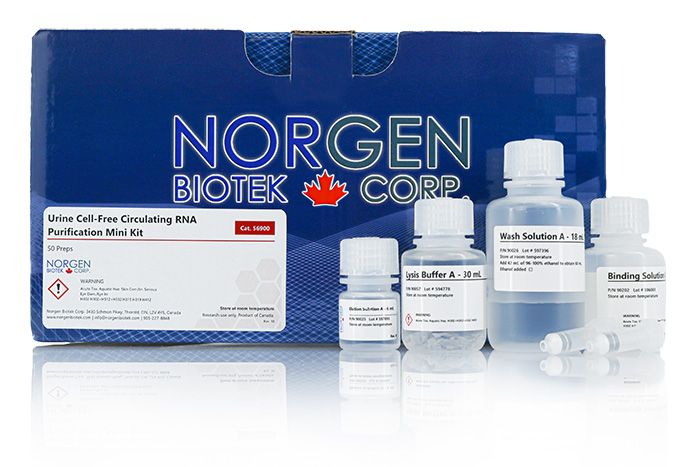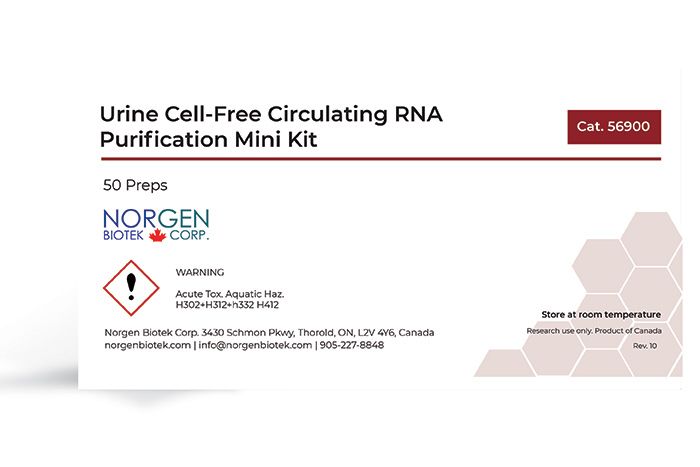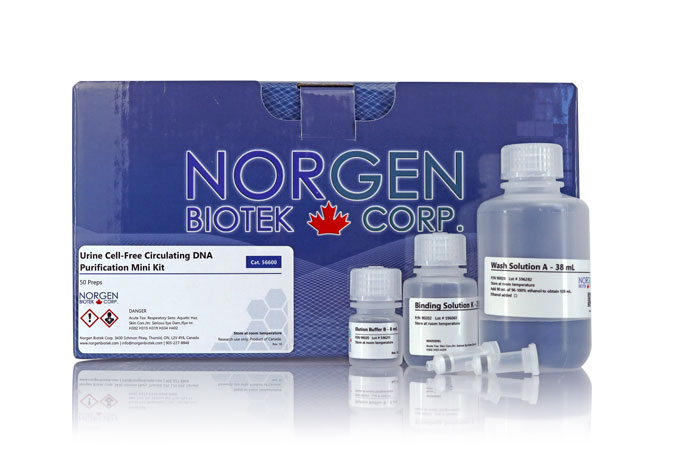Urine Cell-Free Circulating RNA Purification Kits
For isolating circulating RNA and exosomal RNA from urine


For research use only and NOT intended for in vitro diagnostics.

Version Available Here.
Urine Cell-Free Circulating RNA Purification Kits
For isolating circulating RNA and exosomal RNA from urine
Register today to receive an exclusive 15% off* on your first order.
Features and Benefits
- Isolate all sizes of circulating and exosomal RNA, including microRNA
- Versatile urine input ranges
- No phenol extractions
- No carrier RNA
- Bind and elute all RNA irrespective of size or GC content, without bias
- Concentrate circulating RNA and exosomal RNA into flexible elution volumes
- Purified RNA is suitable for a variety of downstream applications, including Small RNA Sequencing. Find out more information on Norgen's NGS services
- Purification is based on spin column chromatography that uses Norgen’s proprietary resin separation matrix
These kits provide a fast, reliable and convenient method to purify and concentrate high quality, high purity and inhibitor-free cell-free circulating RNA, including exosomal RNA as well as viral RNA from fresh, preserved or frozen urine samples. All components for the purification are provided in one convenient and fast kit for the easy processing of small input volumes of bodily fluids. The purified urine RNA is fully compatible with all downstream applications including PCR, qPCR, methylation-sensitive reverse transcription qPCR, reverse transcription PCR, Northern blotting, RNase protection and primer extension, expression array assays, and NGS.
Background
Recent evidence indicates that cell-free circulating RNA (cf-RNA) including exosomal RNA in urine contains valuable information for the discovery of biomarkers that can help for the early detection of certain cancer types and for monitoring the disease status as well as for the detection of any infectious pathogens. Exosomes can be found in saliva, blood, urine, amniotic fluid and malignant ascitic fluids, among other biological fluids. Evidence has been accumulating recently that these vesicles act as cellular messengers, conveying information to distant cells and tissues within the body. These exosomes may play a functional role in mediating adaptive immune responses to infectious agents and tumours, tissue repair, neural communication and transfer of pathogenic proteins. For this reason exosomal RNAs may serve as biomarkers for various diseases including cancer. The advantage for using urine as a source for cancer biomarkers is that it can be acquired in large quantities without using invasive procedures. In addition, repeated sampling from the same individual is applicable, which facilitates longitudinal studies. There are many advantages favouring the use of urinary nucleic acid for cancer biomarker discovery over blood, tissue samples or other bodily fluids, including: (1) urine is non-infectious for HIV and less infectious for many other pathogens; (2) the profile of urinary nucleic acid is similar to that in plasma or serum but with a lower concentration; (3) Nucleic acid purification from urine is technically much easier because of its low protein concentration (1000-fold lower than blood).
Urine Cell-Free Circulating RNA Purification Mini Kit
For sample volumes ranging from 250 µL to 2 mL.
Urine Cell-Free Circulating RNA Purification Midi Kit
For sample volumes ranging from 2 mL to 10 mL. The first column will handle the large volume input of urine that is followed by a concentration on a mini column for a final elution of 50 µL to 100 µL.
Urine Cell-Free Circulating RNA Purification Maxi Kit
For sample volumes ranging from 10 mL to 30 mL. The first column will handle the large volume input of urine that is followed by a concentration on a mini column for a final elution of 50 µL to 100 µL
Details
Supporting Data
Figure 1. Purification of cell-free circulating RNA and exosomal RNA from different urine volumes. Norgen's Urine Cell-Free Circulating RNA Purification Mini Kit (Cat# 56900) was used to purify cell-free circulating and exosomal RNA from 0.5 mL, 1 mL and 2 mL urine samples. Two microlilitres of the purified RNA was then used as the template in RT-qPCR reactions to assess the amplification of (A) the housekeeping 5S rRNA transcript and (B) miR-21. The average Ct value for both (A) 5S rRNA transcript and (B) miR-21 is linearly decreasing with increasing the sample input volume.
Figure 2. Linearity of RNA purified from increasing urine volumes. Norgen's Urine Cell-Free Circulating RNA Purification Mini Kit (Cat# 56900) was used to purify RNA from 0.5 mL, 1 mL and 2 mL urine samples. Two microlitres of the purified RNA was then used as the template in RT-qPCR reactions to assess the linearity of the (A) 5S rRNA transcript and (B) miR-21 from the different urine volumes. Norgen's Urine Cell-Free Circulating RNA Purification Mini Kit was able to recover 96% of the 5S rRNA transcript from 1 mL urine relative to the amount that is present in 0.5 mL plasma. Moreover, 96% of the 5S rRNA transcript was recovered from 2 mL urine relative to the amount that is present in 1 mL urine. As for miR-21, Norgen's Urine Cell-Free Circulating RNA Purification Mini Kit was able to recover 92% of miR-21 from 1 mL urine relative to the amount that is present in 0.5 mL urine. Furthermore, 100% of miR-21 was recovered from 2 mL urine relative to the amount that is present in 1 mL urine.
Figure 3. Determination of the amount of inhibition present in urine cell-free circulating RNA samples when detecting the human miR-21. RNA was isolated from 0.5 mL, 1 mL and 2 mL urine using Norgen's Urine Cell-Free Circulating RNA Purification Mini Kit (Cat# 56900). Increasing volumes of the elution (2, 4 and 8 μL) were used in a 20 μL qPCR reaction to observe any decrease in Ct value. An increase in Ct values with increasing amount of template would be a clear indication of PCR inhibitors present in the sample. An increase in elution volume used as a template in the qPCR did not affect the Ct value generated from qPCR and in fact the Ct values tend to decrease with increasing the PCR input volume, indicating that RNA purified from urine using Norgen's kit is free of the common inhibitors usually present in urine.
Figure 4. Purification of cell-free circulating RNA and exosomal RNA from different urine volumes. Norgen's Urine Cell-Free Circulating RNA Purification Midi Kit (Cat# 57000) was used to purify cell-free circulating and exosomal RNA from 2 mL, 5 mL and 10 mL urine samples. Two microlilitres of the purified RNA was then used as the template in RT-qPCR reactions to assess the amplification of (A) the housekeeping 5S rRNA transcript and (B) miR-21. The average Ct value for both (A) 5S rRNA transcript and (B) miR-21 is linearly decreasing with increasing the sample input volume.
Figure 5. Linearity of RNA purified from increasing urine volumes. Norgen's Urine Cell-Free Circulating RNA Purification Midi Kit (Cat# 57000) was used to purify RNA from 2 mL, 5 mL and 10 mL urine samples. Two microlitres of the purified RNA was then used as the template in RT-qPCR reactions to assess the linearity of the (A) 5S rRNA transcript and (B) miR-21 from the different urine volumes. Norgen's Urine Cell-Free Circulating RNA Purification Midi Kit was able to recover 96% of the 5S rRNA transcript from 5 mL urine relative to the amount that is present in 2 mL plasma. Moreover, 97% of the 5S rRNA transcript was recovered from 10 mL urine relative to the amount that is present in 5 mL urine. As for miR-21, Norgen's Urine Cell-Free Circulating RNA Purification Midi Kit was able to recover 98% of miR-21 from 5 mL urine relative to the amount that is present in 1 mL urine. Furthermore, 92% of miR-21 was recovered from 10 mL urine relative to the amount that is present in 5 mL urine.
Figure 6. Determination of the amount of inhibition present in urine cell-free circulating RNA samples when detecting the human miR-21. RNA was isolated from 2 mL, 5 mL and 10 mL urine using Norgen's Urine Cell-Free Circulating RNA Purification Midi Kit (Cat# 57000). Increasing volumes of the elution (2, 4 and 8 μL) were used in a 20 μL qPCR reaction to observe any decrease in Ct value. An increase in Ct values with increasing amount of template would be a clear indication of PCR inhibitors present in the sample. An increase in elution volume used as a template in the qPCR did not affect the Ct value generated from qPCR and in fact the Ct values tend to decrease with increasing the PCR input volume indicating that RNA purified from urine using Norgen's kit is free of the common inhibitors usually present in urine.
Figure 7. Purification of cell-free Circulating RNA and exosomal RNA from different urine volumes. Norgen’s Urine Cell-Free Circulating RNA Purification Maxi Kit (Cat# 57100) was used to purify cell-free circulating and exosomal RNA from 10 mL, 20 mL and 30 mL urine samples. Two microlilitres of the purified RNA was then used as the template in RT-qPCR reactions to assess the amplification of (A) the housekeeping 5S rRNA transcript and (B) miR-21. The average Ct value for both (A) 5S rRNA transcript and (B) miR-21 is linearly decreasing with increasing the sample input volume.
Figure 8. Linearity of RNA purified from increasing urine. Norgen’s Urine Cell-Free Circulating RNA Purification Maxi Kit (Cat# 57100) was used to purify RNA from 10 mL, 20 mL and 30 mL urine samples. Two microlitres of the purified RNA was then used as the template in RT-qPCR reactions to assess the linearity of the(A) 5S rRNA transcript and (B) miR-21 from the different urine volumes. Norgen’s Urine Cell-Free Circulating RNA Purification Maxi Kit was able to recover 95% of the 5S rRNA transcript from 20 mL urine relative to the amount that is present in 10 mL Urine. Moreover, 99% of the 5S rRNA transcript was recovered from 30 mL urine relative to the amount that is present in 20 mL urine. As for miR-21, Norgen’s Urine Cell-Free Circulating RNA Purification Maxi Kit was able to recover 99% of miR-21 from 20 mL urine relative to the amount that is present in 10 mL urine. Furthermore, 96% of miR-21 was recovered from 30 mL urine relative to the amount that is present in 20 mL urine.
Figure 9. Determination of the amount of inhibition present in urine cell-free circulating RNA samples when detecting the human miR-21. RNA was isolated from 10 mL, 20 mL and 30 mL urine using Norgen’s Urine Cell-Free Circulating RNA Purification Maxi Kit (Cat# 57100). Increasing volumes of the elution (2, 4 and 8 μL) were used in a 20 μL qPCR reaction to observe any decrease in Ct value. An increase in Ct values with increasing amount of template would be a clear indication of PCR inhibitors present in the sample. An increase in elution volume used as a template in the qPCR did not affect the Ct value generated from qPCR and in fact the Ct values tend to decrease with increasing the PCR input volume, indicating that RNA purified from urine using Norgen’s kit is free of the common inhibitors usually present in urine.
|
Kit Specifications
|
|
| Sample Volume Range |
250 μL to 2 mL
|
| Size of RNA Purified |
All sizes including small RNA (< 200 nt)
|
| Minimum Elution Volume |
50 μL
|
| Maximum Elution Volume |
100 μL
|
| Time to Complete 10 Purifications |
25-30 minutes
|
| Average Yield* |
Variable depending on specimen
|
*Please check page 6 of the product insert for average yields and the common RNA quantification methods.
Storage Conditions and Product Stability
All buffers should be kept tightly sealed and stored at room temperature. These kits are stable for 2 years after the date of shipment. It is recommended to warm Lysis Buffer A for 20 minutes at 60°C if any salt precipitation is observed.
| Component | Cat. 56900 (50 preps) | Cat. 57000 (20 preps) | Cat. 57100 (10 preps) |
|---|---|---|---|
| Binding Solution K | 25 mL | 75 mL | 1 x 75 mL 1 x 25 mL |
| Lysis Buffer A | 30 mL | 20 mL | 20 mL |
| Wash Solution A | 18 mL | 18 mL | 18 mL |
| Elution Solution A | 6 mL | 6 mL | 6 mL |
| Mini Spin Columns | 50 | 20 | 10 |
| Midi Spin Columns | - | 20 | - |
| Maxi Spin Columns | - | - | 10 |
| Collection Tubes | 50 | 20 | 10 |
| Elution Tubes (1.7 mL) | 50 | 20 | 10 |
| Product Insert | 1 | 1 | 1 |
Documentation
FAQs
Mini, Midi, Maxi
RPM= √RCF/(1.118x10-5)(r)
Where RCF = required gravitational acceleration (relative centrifugal force in units of g); r = radius of the rotor in cm; and RPM = the number of revolutions per minute required to achieve the necessary g-force.
We recommend the following steps to prepare frozen urine for isolation:
- Gently warm the sample to room temperature or 37°C for 5 min.
- DO NOT perform a centrifugation step after thawing frozen cell-free Urine samples - this will eliminate the precipitated proteins leading to loss of protein-bound cf-NA or exosomes.
- Proceed with the protocol.
We recommend the use of Norgen’s Urine Preservative when collecting urine samples. Norgen’s Urine Preservative is designed for the preservation of nucleic acids and proteins in fresh urine samples at ambient temperatures, therefore no protein precipitation will occur and the purified nucleic acids will be of a higher quality.
Citations
| Title | Circular STAG2 RNA Modulates Bladder Cancer Progression via miR-145-5p/TAGLN2 and Is Considered as a Biomarker for Recurrence |
| Citation | cancers 2024. |
| Authors | Chris Du 1,Wayne C. Waltzer 1,Jeremy E. Wilusz 2ORCID,Massimiliano Spaliviero 1,Frank Darras 1 andVictor Romanov 1,* |
| Title | The Small RNA Component of Arabidopsis thaliana Phloem Sap and Its Response to Iron Deficiency |
| Citation | Plants 2023. |
| Authors | Ahmet Bakirbas, Rosario Castro-Rodriguez and Elsbeth L. Walker |



